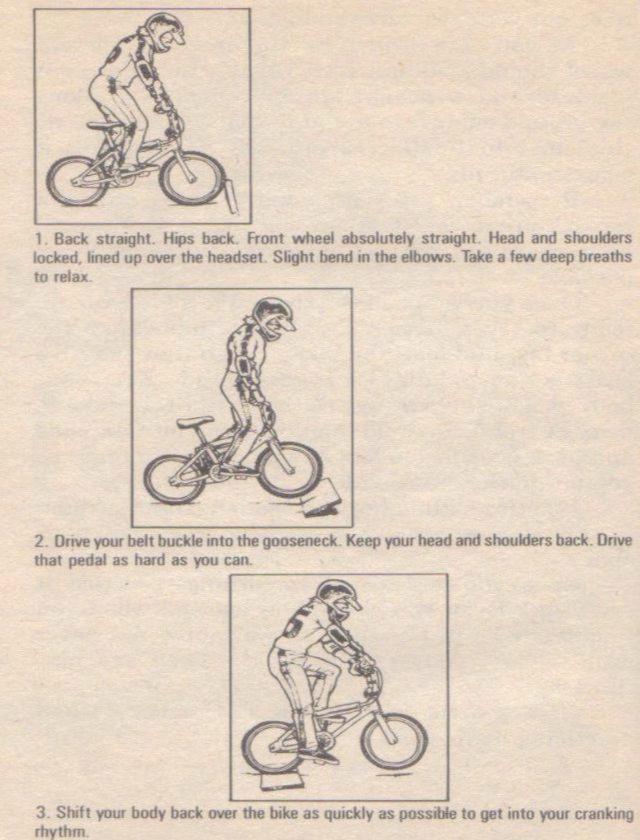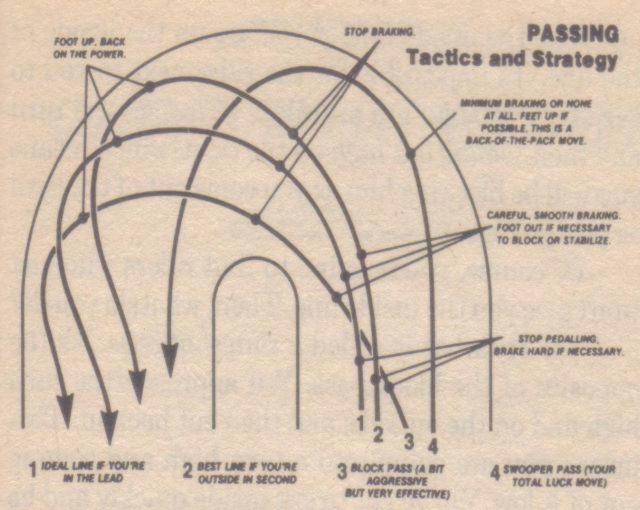
How To Develop Good
BMX Racing Strategy

BMX racing takes more than just strong legs - you've also got
to be mentally prepared. Assuming that you've been doing your
training, these tips will help you use your head in a BMX race.
_______________________________________________________________
|
Much of this advice is aimed towards the newer BMX racers yet this advice remains timeless and helpful. The one thing that makes a BMX rider smoother and faster on the BMX track is practice, practice, practice. Steps:1. Practice at many different tracks. All tracks have different start gates,start hills, jumps, berms and rhythm sections. Be prepared for anything. 2. Practice gate starts from all eight of the lanes. 3. Learn to balance at the gate with both feet on the pedals. This skill will help you get a faster start, and you won't have to worry about missing a pedal once the gate drops. 4. Look at the gate. When you're waiting for the gate to drop, watch the top of the gate instead of the start lights. This step will help you keep your balance and help you prepare for the gate to drop.  5. Focus on the first jump or berm as soon as the gate drops. See where you want to go. 6. Try to get the holeshot, or first position, out of the start gate. This position puts you at an advantage, as long as you can hold the lead. 7. Hold your position. Try not to be too aggressive, but don`t let other riders easily bump you out of the way. 8. Go high and outside on the berms. In most cases, if you`re trying to get a better position, the outside line lets you see what everyone else is doing and react. Be ready to either stay on the outside or pull into the inside line.  9. Stay low on jumps. Most of the time, you`re faster on the ground, so learn how to stay low and how to speed jump. 10. Keep pedaling all the way to the end and even after you`ve crossed the finish line. Many riders who thought they had won slowed down to raise their arms only to have the next rider sneak in and take the win. Tips:When practicing, focus on all aspects of the track. Learn how to hitthe first jump and the first turn from any one of the eight lanes. It is better to jump (instead of roll) over some jumps, like doubles and triples. Don't go higher or farther than you have to - stay smooth and keep your momentum. Sometimes riders use their elbows to force other riders out of the way in the turns. You'll need to learn how to handle that tactic and realize that it is part of racing. The best way to avoid this situation is to be faster than the other riders. ~~ Some Racing Tips For Bigger Riders ~~1. Use your weight and power to your advantage. Remember that you will power down a start hill and off a berm faster than most. Don't be intimidated by smaller, more agile riders, as they are like bugs on a windscreen. If you are determined in a first corner hustle, use your aggression and inertia to cut or barge through the pack (if you don't get great starts). You can also cut back if you got a slow start - go hard into the first half of the berm, then cut back down underneath the others on the way out. 2. Remember to warm up and stretch before and after practice, or on race days. If you don't, your lower back will make you pay for it. Most professionals stop racing due to lower back problems, so keeping yours stretched and warmed up properly is very important. 3. Gearing is also important to a bigger rider. If you have power to spare, try running a taller gearing like 45/16 or 43/15. If you want, accelerate quicker out of starts and turns. Try 44/16, 43/16, or 42/15. If a particular gearing feels right to you, then it is right. Don't worry about the gearing others are using. They are most likely a different style, age, ability, and size to you. If you do worry about your lower back, stick to a shorter gearing to make it easier on you. 4. Run the lightest tire you can find on the rear wheel of your race bike. Any weight saved will enable you to accelerate faster. To prove this, put a 20 x 2.125 on your bike. Do some starts (it will be really lousy out of the gate, and it will be hard to do a full lap without draining your energy). Then try a 20 x 1.75 (this should feel better). Then (if you dare), try a Primo 1.50 rear tire (it's magic for take off and traction). Run it between 40-60 psi. The same applies for your front tire, also I run a Maxxis Max Daddy 20 x 1.75 on the front, equivalent to 20 x 2.00 on other makes and a Primo 20 x 1.5 on the back. Adjust the front pressure to suit yourself, as the front is your steering, traction, and suspension all in one (try 30-40 psi). 5. Keep your chain tensioned fairly tight, as you will develop a bit of chain whip if it is too loose. You don't want to be thrown over the handlebar as a result of frame flex and chain whip. 6. Keep a strong frame, and use the lightest (and strongest) wheels you can afford. A frame is fairly static, so you are actually pushing the wheel weight around when you pedal. If you ride an alloy frame, check it periodically for cracking. Alloy frames are stiff, but it only takes a couple of years of hard racing (and some big get-offs) to damage them. A CroMoly frame doesn't fatigue or crack as much, but it will flex more underneath you (when you crank hard). 7. Practice manual wheelies using flat pedals (clips are only good if you've mastered it). Keep one finger on your brake lever. If you start to loop, you can touch the brake to bring the front end back down. 8. Do not use clips in a race until you are really good at jumping and balancing at the gate. Ride trail jumps when you can (to get your skills up), and practice keeping your bike low over jumps at the track(speed jumping).If you must use clips, remember that in the air, your body language will affect how you land (and at what angle). If you get out of shape, try a little twist with your lower half to bring the bike back around to where it should be. If you want to manual jump, just remember to start small and eventually work up to the longer manuals in a race. If you don't, you may bounce off a landing ramp or over your handlebars. Keep it nice and smooth. 9. Most of all, enjoy your racing! If you are ambitious, "plan to win" by assessing the day's racing, and look at what you can do to improve your rides next time. That may mean anything from a form of endurance training (like running, cycling, interval training, going to practice every week), or maybe chilling out on your bike each day after school (or work) at the local trails or track. Spend time on the bike so you can be forceful, assertive, and confident in your abilities on and off the race track. Good Luck, And Have Lots Of Fun In BMX Racing.:) For More Information About BMX Racing Strategy And Training See: www.bmxtraining.com | www.bmxschool.com Also Check Out Some Cool Sources Found On The Web: Want To Step Up Your Bike Handling Skills On The Road Or Trail? Turn To BMX! USA Cyclings National BMX Coach James Herrera Offers Four Tips On Using BMX Moves To Become A Better Cyclist. * Improve Your Road And Mountain Bike Skills With BMX Moves. - Bicycling Magazine. How To Train For BMX Racing: * http://www.wikihow.com/Train-for-BMX-Racing BMX Race Taining: Sprints, Sprints, Sprints And More Sprints: * http://www.goldcoastbmxclub.com/training.html How To Get A Gate In BMX Racing: * http://www.ehow.com/how_2252185_get-gate-bmx-racing.html * http://www.wikihow.com/Get-a-Gate-in-BMX-Racing Pickle`s How To Start, Pass, Jump: * http://www.artcycles.com/bmx/bmxtutor.htm A How To BMX Racing YouTube Video: Redline BMX Jason Carnes Flight School. * www.youtube.com/genesbmx/Playlist/Redline BMX Jason Carnes Flight School Some Other Cool How To BMX Race YouTube Videos: How To Race BMX:- Gate Start: * www.youtube.com/watch?v=nlXavqvgf6A How To Race BMX:- Pumping: * www.youtube.com/watch?v=lhee049EW10 How To Race BMX:- Manual: * www.youtube.com/watch?v=gL46U4FNABM |
|---|
_______________________________________________________________
***** Gene`s BMX *****
All Things Northwest in BMX!
http://www.genesbmx.com